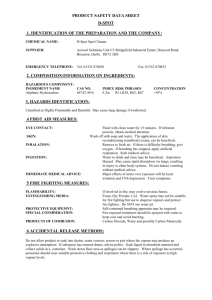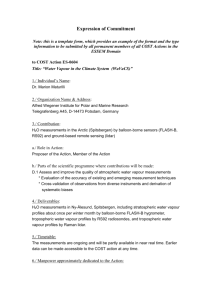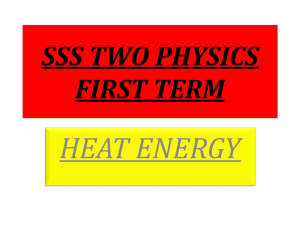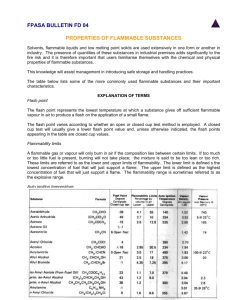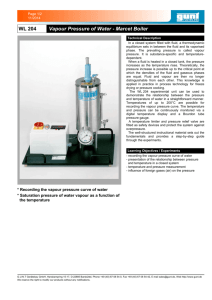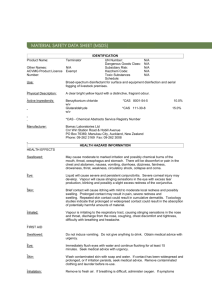The Vapour Pressures of the Platinum Metals
advertisement
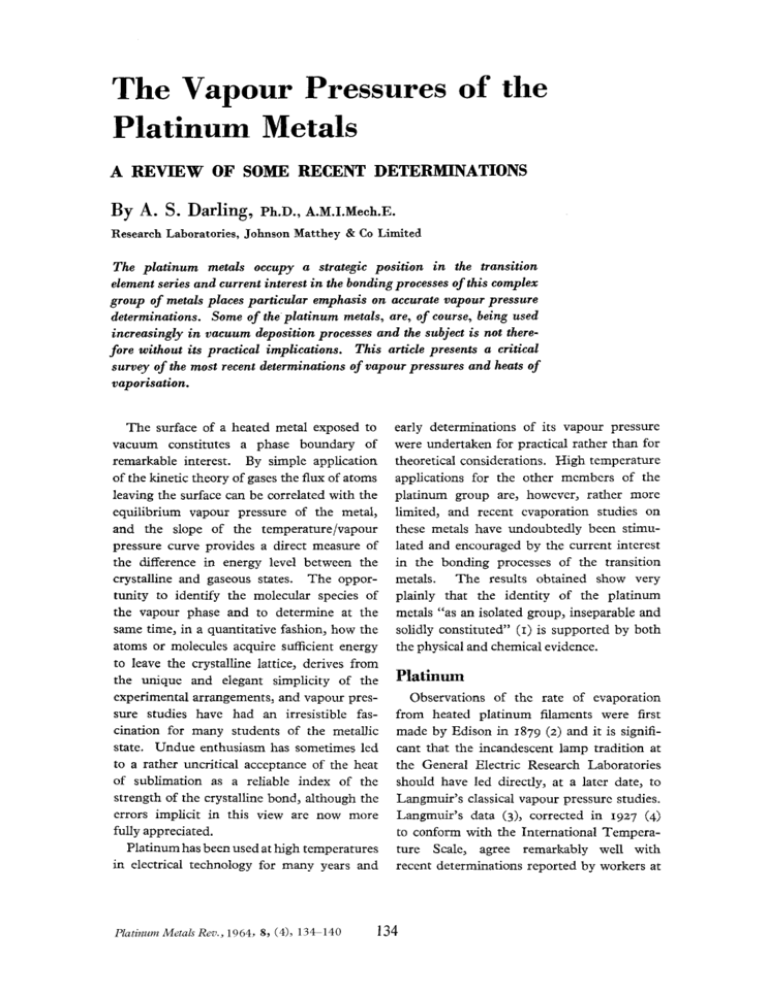
The Vapour Pressures of the Platinum Metals A REVIEW OF SOME RECENT DETERMINATIONS By A. s. Darling, Ph.D., A.M.1.Mech.E. Research Laboratories, Johnson Matthey & Co Limited The platinum metals occupy a strategic position i n the transition element series and current interest in the bonding processes of this complex group of metals places particular emphasis on accurate vapour pressure determinations. Some of the platinum metals, are, of course, being used increasingly i n vacuum deposition processes and the subject is not therefore without its practical implications. This article presents a critical survey of the most recent determinations of vapour pressures and heats of vaporisation. The surface of a heated metal exposed to vacuum constitutes a phase boundary of remarkable interest. By simple application of the kinetic theory of gases the flux of atoms leaving the surface can be correlated with the equilibrium vapour pressure of the metal, and the slope of the temperature/vapour pressure curve provides a direct measure of the difference in energy level between the crystalline and gaseous states. The opportunity to identify the molecular species of the vapour phase and to determine at the same time, in a quantitative fashion, how the atoms or molecules acquire sufficient energy to leave the crystalline lattice, derives from the unique and elegant simplicity of the experimental arrangements, and vapour pressure studies have had an irresistible fascination for many students of the metallic state. Undue enthusiasm has sometimes led to a rather uncritical acceptance of the heat of sublimation as a reliable index of the strength of the crystalline bond, although the errors implicit in this view are now more fully appreciated. Platinum has been used at high temperatures ir, electrical technology for many years and Platinum Metals Rev., 1964, 8, (4.1, 134-140 early determinations of its vapour pressure were undertaken for practical rather than for theoretical considerations. High temperature applications for the other mcmbers of the platinum group are, however, rather more limited, and recent cvaporation studies on these metals have undoubtedly been stimulated and encouraged by the current interest in the bonding processes of the transition metals. The results obtained show very plainly that the identity of the platinum metals “as an isolated group, inseparable and solidly constituted” (I) is supported by both the physical and chemical evidence. Platinum Observations of the rate of evaporation from heated platinum filaments were first made by Edison in 1879 (2) and it is significant that the incandescent lamp tradition at the General Electric Research Laboratories should have led directly, at a later date, to Langmuir’s classical vapour pressure studies. Langmuir’s data (3), corrected in 1927 (4) to conform with the International Temperature Scale, agree remarkably well with recent determinations reported by workers at 134 Fig. 1 Experimental vapour pressure data on platinum and palladium the United States Bureau of Standards (5). These experimenters, together with Dreger and Margrave (6), employed the Langmuir free evaporation technique and the results should therefore be directly comparable. Dreger and Margrave, however, heated their specimens indirectly i8by radiation from a graphite -9 susceptor. By using a water cooIed flux concentrator Hampson and Walker avoided any possibility of carbon contamination, and this precaution probably accounted for their higher vapour pressure measurements. I n the Langmuir technique vapour pressures (P) are calculated from the rate of evaporation (m) in accordance with the expression : / / /+ TEMPERATURE where a is the accommodation coefficient, M is the molecular species and T the absolute temperature. The method has often been criticised because the accommodation coefficient is not necessarily unity. In most experiments, however, this uncertainty is a minor source of error. From the experimental results plotted in Fig. I it will be seen that a 7% temperature variation will completely mask any error caused by a 25 per cent change in accommodation coefficient. Temperatures must usually be optically determined, and as surface evaporation leads to a continuous change of emissivity, it will be appreciated that the main errors in Langmuir experiments originate in faulty temperature measurement. Platinum Metals Rev., 1964, 8, (4) Liquid metals sometimes have very low accommodation coefficients and this subject has been reviewed by several authors (7, 8). Most of the experimental evidence suggests, however, that erroneously low evaporation rates are unlikely to be consistently obtained from determinations on solid specimens. Systematic errors can usually be revealed by extrapolating the apparent vapour pressure curve backwards. If this yields a plausible heat of evaporation, the accommodation coefficient is unlikely to be much less than unity. Further confirmation can be obtained by drilling holes in the specimen to increase its total surface area. Reentrants of this type will only result in an increased evaporation rate if x is significantly less than unity. Errors caused by an intermittent change in accommodation coefficient can often be avoided by varying the temperature in a random manner. Hampson and Walker’s work (5) provides a good illustration of this technique. Variations of surface conditions sometimes led to anomalously low evaporation rates that were so obviously inconsistent with 135 -2 Fig. 2 Experimental uapour pressure datu an rhodium and iridium 10 G3 RHODIUM + KNUDSEN 12.13 0 LANGMUIR 16 LANGMUIR 5 - (5 a -4 p 10 2 2 Y g -! 10 a 3 0 B 'lo' LANGMUIR 12, 13 determinations and corresponds to a +- 25 per cent limit of error in vapour pressure measurement. 4 Palladium - ~ 10 1600 1800 2000 2400 2200 TEMPERATURE 2600 K the bulk of the data that they could be safely ignored. The conditions causing these stages of low evaporation were not fully understood, except that they tended to occur after fairly lengthy periods at high temperature. "Normal" sublimation rates were readily restored by a sudden rise in temperature. It appears reasonable to attribute the low vapour pressure determinations of Dreger and Margrave to a 50 per cent decreasc in accommodation coefficient caused by carbon contamination. In view of the excellent agreement between Hampson and Walker's data and those of Jones, Langmuir and Mackay, the NBS vapour pressure equation : Log P,,--9.642- 27,575 __ T appears to be applicable from 1650°K to the melting point of platinum. All three sets of results yield concordant heats of sublimation, varying from H,(298) -134.6 kcal' mole for Jones e t al. to 135.2 kcal/mole for Dreger and Margrave. After making allowances for experimental scatter, errors in temperature measurements and weight loss measurements, Hampson and Walker conclude that H,(298) -134.9 - 1.0kcaI/mole, a value which embraces the other two sets of Platinum Metals Rev., 1964, 8, (4) The general belief that palladium had the highest vapour pressure of )O the platinum metal group was, until comparatively recently, supported by very little reliable evidence. The first serious determinations were those of Haefling and Daane (9) who used the Knudsen technique and lined their graphite effusion vessel with tungsten. Measurements were made at temperatures just below the melting point of palladium. Their results, shown in Fig. I, were approximately one order of magnitude higher than those of Dreger and Margrave (6) who used the Langmuir method and measured the rate of loss of weight of a palladium rod heated by radiation from a graphite susceptor. Haefling and Daane's (9) heat of sublimation, calculated from the shape of the vapour pressure curve, was 80 kcal/mole at 298"K, and considerably below the mean value of 91.0 obtained by Drcger and Margrave. The pronounced temperature dependence of both sets of results indicates some type of systematic error. The graphite effusion vessel of Haefling and Daane was not degassed above 1500°C and might well have lost weight during the experiment, thus causing erroneouslq high vapour pressure determinations. The presence of carbon vapour could easily have influenced Dreger and Margrave's determination in the opposite sense, by reducing the accommodation coefficient. 136 Hampson and Walker (10)at the Bureau of Standards used a water cooled copper flux concentrator for heating their palladium specimens and avoided any possible uncertainty. Their results, shown in Fig. I, are intermediate between those of the previous investigators. A comparison of the platinum and palladium results shows that in both instances the vapour pressure determinations of Hampson and Walker are approximately 50 per cent higher than those of Dreger and Margrave. Since both groups of workers paid particular attention to the precision of their temperature measurements, the discrepancy is reasonably attributable to the presence of some unsuspected surface contamination emanating perhaps from the graphite susceptor. The NBS determinations are very consistent and their vapour pressure equation (10) Log P,,=8.749 18,655 -- T appears to be applicable from 1200" to 1700°K. The mean heat of sublimation was estimated to be 89.2 kcal/mole at 298°K with an overall limit of error of 5 0.8 kcal/mole, corresponding to a possible uncertainty of f 33 per cent in the vapour pressure measurements. Iridium Vapour pressure determinations on iridium by both the Knudsen and Langmuir techniques have been recently reported by Panish and Reif (11, 12, 13) whose results link up remarkably well with the lower temperature values obtained at the NBS (5). The first published information ( I I) was obtained with Investigators effusion cells having an orifice too large to ensure internal saturation. This led to improved Langmuir and Knudsen experiments which provided mutually confirmative results. The high consistency of the experimental data plotted in Fig. 2 suggests that iridium under high vacuum conditions has an accommodation coefficient of unity and that no serious errors are involved in using the free evaporation method. Hampson and Walker (5) did, however, report one or two test runs in which the indium refused to evaporate. It seems reasonable to attribute this effect to carbon contamination, as the NBS apparatus, although protected with a liquid nitrogen trap, was evacuated by an oil diffusion pump. Panish and Reif used ionisation pumps, and as their vacuum was less likely to be contaminated by hydrocarbon vapours, it became possible to study the effect of carbon in an unambiguous manner. The presence of graphite within the effusion cell was shown (13) to reduce the vapour pressure of iridium by one or two orders of magnitude. Carbon apparently does more than merely reduce the accommodation coefficient of heated iridium although Panish and Reif were unable to observe any signs of surface reaction. Under suitable conditions atomically clean surfaces of refractory metals can be produced by heating in high vacuum (14). This method is particularly applicable to iridium whose surface impurities are all likely to be more volatile than itself. The high catalytic activity of iridium, however, indicates that vacuum conditions are likely to be stringent. Vapour Pressure Equation Temperature Range Panish et al. (13) Hampson and Walker ( 5 ) Log,oPmm=10.46 - 33y980 T Log,$,,= Platinum Metals Rev., 1964, 8, (4) 10.020- 331337 ___ T 137 Heat of Vaporisation H,,, kcal/mole 2100-2600~K 1986-2260~K Isg.9&2.0 -I 10 Fig. 3 Experimental vapour pressure data on osmium and ruthenium RUTHENIUM -2 10 (I3 +l7) 0 EFFUSION ' l 3 i O R l F l C E + EFFUSION '/16'0RIFICE A LANGMUIR -3 a a lo 2 z w -4 10 a At 2030'K this curve links up with that of Panish and Reif ( IZ),which is applicablebetween 2050 and 2200OK. 3 ln -5 I10 a 3 2 -6 1 0 1 -7 10 2000 A LANGMUIR (17) Log P,= 10.28 - __ 2 8 ; m (12) / 2100 2200 2300 2400 2500 TEMPERATURE K ' 2600 Roberts (15) has reported that iridium cracks ethylene at IOOOCto produce a tarry deposit and these reactions are likely to be greatly accelerated at higher temperatures. Panish et al. (13) used a time of flight mass spectrograph to confirm the monatomic nature of iridium vapour. Their vapour pressure equation is almost identical with that of Hampson and Walker, both of which are tabulated at the foot of page 137. Rhodium Three independent groups of investigators have studied the vapour pressure of rhodium with results as indicated in Fig. 2. Their continued use of a graphite susceptor probably explains why Dreger and Margrave's data (16) are less consistent and tend to be lower than those of Panish and Reif (12, 13) or Hampson and Walker (5). In view of the excellent agreement between the results obtained by free evaporation and by effusion there appears to be little doubt that rhodium, when heated in a clean vacuum, has an accommodation coefficientapproaching unity. The vapour is monatomic (13). Between 1700 and 2075°K the vapour pressure is best defined by the following equation: 271276 L0g10P,rn==9.775 - T ( 5 ) Platinum Metals Rev., 1964, 8, (4) Third law analysis of the 2aoorhodium evaporation data by Panish and Reif yielded a heat of evaporation of AH,,, 7132.8 h0.3 kcal/ mole, which agrees well with Hampson and Walker's value of 132.5 f2.o kcal/mole. 2700 Osmium Langmuir experiments by Panish and Reif (17) on sintered cylinders heated by an electron beam showed that the vapour pressure of osmium is less than I O - ~mm of Hg at 2100'C. The vapour is monatomic, and the best line through the experimental points on Fig. 3 is represented by: Third law calculations using standard free energy functions yielded a heat of vaporisation at 298°K of 187.4h0.9 kcal/mole. This value is considerably higher than earlier estimations (18, 19). Ruthenium Panish and Reif have studied the evaporation of ruthenium in considerable detail (13~17).Due to a reaction between ruthenium and the effusion cell liner appreciable quantities of thoria were found on the targets and this made it impossible to use w-eight changes as an index of evaporation rates. The quantity of ruthenium emanating 138 -2 10 Fig.. 4 Rates qf evaporation in vacuo of the six platinum metals -3 10 i . . 104 from the cell was determined, therefore, by the use of Ru as a tracer. The vapour pressure determinations made with & inch and & inch diameter orifices, although scattered, fell along the same line as those of the Langmuir experiments. Added confirmation that the accommodation coefficient of ruthenium was unity was obtained by grooving the specimens to double their total surface area. This had no effect upon the evaporation rate. The line drawn through the experimental points on Fig. 3 is represented by the equation: N I v I -5 10 u I -6 3 f3 1 0 V s f -7 10 z 2 -8 10 c Q d P 0 p -9 10 W 8 -10 w (0 k d -11 10 33,480 (17) 10.81 - T Log,,P,,= -12 10 I 1 I 1200 1400 1600 I 8 0 0 2 0 0 0 2 2 0 0 2 4 0 0 The heat of vaporisation, calculated from TEMPERATURE O C the vapour pressure measurements with the aid of appropriate free energy functions, was found to be AH,,, =154.9 f1.3 kcal/mole. which falls just within the uncertainty range At the upper level, Panish and Reif heated of the most reliable recent melting point their specimens, without melting, to 2318°C~ determinations (20). Rates of Evaporation 1-0 0.9 0.8 .---. N 5 0.7 y" L 0 0 w x > -t-=! 05 g U U-J J - W a 0.4 The curves in Fig. 4 show the theoretical rates of evaporation from the surface of pure platinum metals in vacua The volatility of palladium is approximately 9 orders of magnitude higher than that of osmium. In spite of their higher melting points rhodium and ruthenium evaporate more rapidly than platinum and iridium respectively, and the curves provide an effective illustration of the higher thermal stability of the heavier triad. 50 U 0.3 , 41 73 42 14 43 44 45 76 71 ATOMIC NUMBER 15 Platinum Metals Rev., 1964, 8, (4) 46 70 0.2 47 79 4a 80 139 Fig. 5 Heats of vaporisation and compressability data plotted as a function of atomic number. (Compressibiliries from Bridgman, 1949 (23). Heats of vaporisution for metals other than those in the platinum group from Honig (24)) 8 A. N. Nesmeyanov, Vapour Pressure of the Chemical Elements, 1963, Amsterdam, The theory of the transition metals is still a matter of considerable controversy, and vapour pressure measurements have been used to cast light on the atomic bonding processes. Robins, in 1959 (21), postulated that the metals towards the centre of the second and third long periods tended towards higher stability as the number of bonding electrons approached half the effective coordination number. T h e high heats of vaporisation of tungsten and molybdenum were used as an illustration of this conception. Compressibility values, which according to other authorities (22) provide a more reliable indication of bond strength in the crystalline state, reach minimum values at ruthenium and iridium. The heats of evaporation and compressibilities of the elements most concerned in these hypotheses are plotted in Fig. 5. I 2 3 4 5 6 7 Elsevier 9 J. F. Haefling and A. H. Dame, Trans. Met. SOC. A.I.M.E., I9581212,115 10 R. F. Hampson and R. F. Walker, J. Res. Nut. Bur. Stand., 1962, 66A, (2), 177 X I A. A. Hasapis, M. B. Panish and C . Rosen, The Vaporisation and Physical Properties of Certain Refractories, Part I, WADD-TR60-463, Oct. 1960 IZ M. B. Panish and L. Reif, J. Chem. Phys., 1961,34,(6), 1915 13 A. A. Hasapis, A. J. Melveger, M. B. Panish, L. Reif and C. L. Rosen, The Vaporisation and Physical Properties of Certain Refractories, Part 11. WADD-TR-60-463, Oct. 1962 14 R. W. Roberts, Brit.J. Appl. Phys., 1963, 14, (91,537 15 R. W. Roberts, Trans. Faraday Sot., 1962, 58, 11.59 16 L. H. Dreger and J. L. Margrave, J . Phys. Chem., 1961,65, (II), 2106-2107 r7 M. €3. Panish and L. Reif, J. Chem. Phys., 1962,37, (I), 128 18 D. R. Stull and G. C . Sinke, Thermodynamic Properties of the Elements, American Chemical Society, Washington, D.C., 1956 19 L. Brewer, Paper No. 3, Chemistry and Metallurgy of Miscellaneous Materials, edited by L. L. Quill, McGraw-Hill Book Co, New York, I950 20 E. Anderson and W. Hume-Rothery, J . Less Common Metals, 1960, 2, (6), 413-450 21 D. A. Robins, J. Less Common Metals, 1959, I, 396-410 22 W. Hume-Rothery and B. R. Coles, Advances in Physics, 1954,3, (10)149-243 23 P. W. Bridgman, The Physics of High Pressures, 1949, G. Bell, London 24 R. E. Honig, R.C.A. Rev., 1962, 23, (4), 567-586 References C. E. Claus, J . Prakt. Chem., 1860, 80, 282 (ChemicalNews, 1861,3,194) T. A. Edison, Chem. News, 1879,40, 152-154 I. Langmuir and G. M. J. Mackay, Phys. Rev., 1914, 41 377 H. A. Jones, I. Langmuir and G. M. J. Mackay, Phys. Rev., 1927, 30, 201 R. F. Hampson and R. F. Walker, J. Res. Nut. Bur. Stand., 1961,65A, (4) 289 L. H. Dreger and J. L. Margrave, J . Phys. Chem., 1960,64, I323 0. Knacke and I. N. Stranski, Progress in MetalPhysics, 1956,6,181 Co-precipitation of Alloy Powders Co-precipitation or co-reduction of two or more platinum metals from mixed solutions of their salts has been widely practised in the past but there are few records of any study of the structure of the resulting powders. I n a letter to Nature (1964, 203, 857) Eugene L. Holt, of Esso Research & Engineering Co, reports on the examination of some platinum-gold, platinum-iridium and palladium-gold powders made by reducing mixed o.gM chloride solutions with 1.8gM sodium borohydride solution at 50°C. The powders precipitated from platinum-gold solutions had compositions corresponding Platinum Metals Rev., 1964, 8, (4) closely to those of the solutions from which they were formed and X-ray analyses indicated them to have the structure of a uniform solid solution of the two metals. Solid solution powders containing 40, 60 and 80 per cent of gold were made in this manner. Powders precipitated from platinum-iridium solutions, however, contained appreciably less iridium than the solutions from which they were precipitated and the powders from solutions containing 80 per cent of iridium, for example, showed two sets of X-ray patterns indicating the presence of a platinum-rich alloy and an iridium-rich alloy. I40

